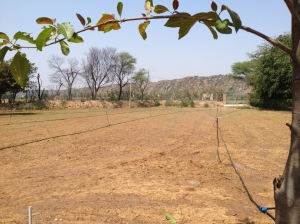Three articles in the Indian Express last week caught my imagination. The first two are worth reading for alternate views of what is going on in India today, and the third by Himanshu of JNU for what went on in the name of development over the past 10 years when the Congress was in power in Delhi.

Famous 6 of Aman Bagh
The social activists (BJP minister Goyal calls them ‘obstructionists’) Nikhil Dey and Aruna Roy wrote on 03 January 2014 about the farce that is the Adarsh Gram scheme of the central government http://indianexpress.com/article/opinion/columns/one-adarsh-village-is-not-enough/.
The next one was by economically right wing ideologue and ardent Modi supporter Surjit S Bhalla. http://indianexpress.com/article/opinion/columns/no-proof-required-why-no-applause-for-modis-reforms/ on 27 December 2014
On the same day (opposite Bhalla’s article), JNU professor Himanshu wrote on The Great Forgetting where he says ‘in the golden decade of Indian agriculture, farmers’ situation has not improved’. http://indianexpress.com/article/opinion/columns/the-great-forgetting/
Two conclusions from these articles: one, the ruling urban elite continues to ignore the village economy, the small and marginal peasant and the rural poor; just as it has done since independence and before. The second is about the realization by urban (necessarily elite) opinion makers who had come to support Modi that he is not quite the reformer they thought he would be. As Arun Shourie said famously some weeks back “After all is said and done, more is said than done”.
Invisible Rural India: where has the villager disappeared from ‘civil’ discourse?
Dey and Roy boldly assert “The first nine months of the new BJP government has only underscored its anti-poor, anti-rural image. The substantive and substantial changes in rural development have been restrictive in nature.” Symbolism is the only winner in the Adarsh Gaon Yojana. My post https://amanbagh.wordpress.com/2014/11/17/tendulkar-and-the-village/ of 17 November 2014, predates Dey and Roy.
This scheme is the token parliamentary nod to the village, leaving the ruling elite even freer to pursue its path to self-enrichment in the city, for the city. All Members of Parliament are co-opted urban elites, even if they represent overwhelmingly rural constituency (and at last count, 65% of our population yet lived there). These MPs are busy making money for themselves, for their next parliamentary or state or district election, organizing communal or caste or some similar chauvinistic polarization and in general not doing anything substantial that could bring systemic economic and social change to rural India. How many of these elected elites live in or even visit the village? Do they ever spend time listening to the issues of rural India? How many of them attempt to find solutions to these issues?
The government machinery – bureaucrats, politicians, police – does not understand the village or is too distanced to want to do anything other than pay lip service and launch schemes for patronage till the next election. Caste and class elites flee the strife, backwardness and poverty of village life instead of engaging with it.
Himanshu is clear that the government has failed the farmer when he says “But the fact that most government interventions have failed to reach farmers, despite increased financial outflow, is evidence of the government’s failure to understand the nature of farming in this country, or the situation of farmers.”
The BJP government and the media savvy PM is busy ‘tweeting’ (how horrible does that sound) its business friendly policy changes through the social media. The English general and business press is filled with breathless reports on the steps taken to attract foreign capital, to make it easier to do business in India and investor summits are being held from Gandhinagar to Ahmedabad to attract investments in industry or services.
Where is serious engagement of this government machinery with thinking society? Defense manufacturing and IT services will solve the myriad issues of our myriad hued poverty struck population in the villages? Really? Won’t these jobs – when they do come online in 5 years – be cornered by the urban educated and skilled? Most of our 800 million rural citizens live on the edge of subsistence, many of them in poverty and hopelessness.
Himanshu says “But this is not surprising, given that, for the majority of small and marginal farmers, agriculture is the only livelihood. Even though the report suggests a growing diversification of their income portfolio, agriculture still accounts for roughly half of their total income. The vulnerability of farmer households becomes apparent in the fact that, in most cases, the income from agriculture is barely enough to keep the household above the poverty line. For most small and marginal farmers, even those with other sources of income, consumption expenditure exceeds income from all activities.”

This is My Land
There is absolute silence on the issues of employment generation in the rural areas, and of making the village a place to live in. Its called agriculture, stupid! Even in the Eighties and Nineties, when there was heated public debate on the terms of trade for farmers there was little change in the ground realities – public and private investments continued to flow into industry that generated returns for those with the capital, away from rural livelihood and employment generation where the market is not developed. Since then, neither has there been any significant enhancement in government investment or efficiency of services in areas relevant to long term rural livelihood sustainability like animal husbandry, means of traditional organic farming, rural supply chain enhancement, local seed preservation, small and cottage industry and for appropriate rural services. And obviously there is no sustained investment and measurement of progress in the quality village sanitation, education or health.
Himanshu is prescient when he states “The growth of agricultural productivity in the last decade appears to be driven by the private initiative of small and marginal farmers rather than the efforts of the government.” I haven’t had a single government functionary visit my farm in rural Faridabad, Haryana in 3 years, and all the benefits we derive are solely on the basis of the hard work of the marginal peasants who work my land. The government is absent, away partying in nearby Gurgaon, Faridabad or distant Chandigarh.
More Is Said Than Done
Arun Shourie has recently been critical about this BJP government, and Surjit Bhalla and his ilk – vociferous and jingoistic supporters of Modi as the development messiah – are depressed by the divisive and backward agenda the BJP and its associate organizations are following.
The problem with the BJP phenomenon is the strange premise that a backward and conservative social agenda can co-exist without contradiction in with a message of economic development and prosperity. I believe the BJP has never had an independent and thought out economic policy that is targeted at enhancing the prosperity of our overwhelmingly rural and poor populaions, and that they are defined primarily by a socially regressive agenda of which being stridently anti Islam and anti Christianity is a key unifying strategy to get around strong caste affiliations. The BJP faithful and the neo-faithful believe in the great antiquity and greatness of a monolithic Hindu civilization, in the achievements (real or otherwise) of Hindu ancestors in the undocumented past, in the need for caste as a unifying authority in changing Hindu society. All is well if a Hindu Samrat rules Bharat, forget the poor. Our schools and society has grown up on the drivel of ruling or dominant caste elites defending Hindu honor, when in historical reality every Hindu ruler and landlord was as self-seeking, rapacious and exploitative as the Muslim ruler or landlord. The intent is to go back to Ram Rajya in a socially retrogressive manner, where a benevolent dictator feeds the population on a diet of dreams and global greatness. Hindu strength based on a militarily powerful nation. Dreams of world domination in the (now not so distant) future.
We know Modi is an urban and urbanizing leader, as is his finance minister Arun Jaitley so is it surprising their policies are urban oriented, with little for the village? Has anyone seen or read a detailed framework and execution plan of a pro-poor, pro-rural economic and social worldview of the BJP? That’s because it has none, and the only truly mass and rural oriented political party manifesto was that of the Janata Party in 1977 where the BJP was a reluctant participant. The corrupt Congress launched some reasonably good programs for the rural poor, while they stole the country blind through urban and capital intensive oriented policies – they rode two horses, the capitalist one which supported urban consumption manufacturing, and the jholawala programs. They needed the shield of the poor to steal from them.
The BJP doesn’t know quite what to do with the Congress rural poor handouts and employment generation programs, as it had no economic view or policy or plan. Should it oppose these as they were ‘Congress programs’, or reform them to make them targeted and more effective? So, Smart Cities and Bullet Trains. And export teachers, manufacture guns also for export, and be happy we had an Aeronautical Division in 5000 BC.
Fast Forward as we Muddle Along
Over the coming 9 years when the BJP will be in power, I can safely predict that the village economy will remain neglected by the ruling urban elite, the small and marginal farmer (80% of Indian peasants who own less than 5 acres of land) will become even more impoverished, our land and water and bodies will get further poisoned by chemical farming, capital shall flow to areas where the urban elite and aspiring urban wannabes hold sway, the rich shall get much richer and inequality shall grow by leaps and bounds.
That is par for the course since 1910, or 1940 or 2015 – so, in a sense, we are not not worse off; other than living with the comfort that the exploiter is one of us and not British or a Raja or Zamindar. We continue to excel at exploiting others, in dominating those weaker than us, in hating the Other. Its not a pretty picture.
Where we will become worse off is as our society becomes increasingly Hindutva-ised, which to me means less accepting of differences, less open to social change, more socially backward and conservative. Or will I be proved wrong by a new generation who will rebel, fight conservatism, open their arms to the Other, and to embracing humanist and universalist ideals that topple the heady power of capital, religion and caste. I live in hope, and do what I can where I can. For sure, my Aman Bagh is increasingly within me.

Happiness















